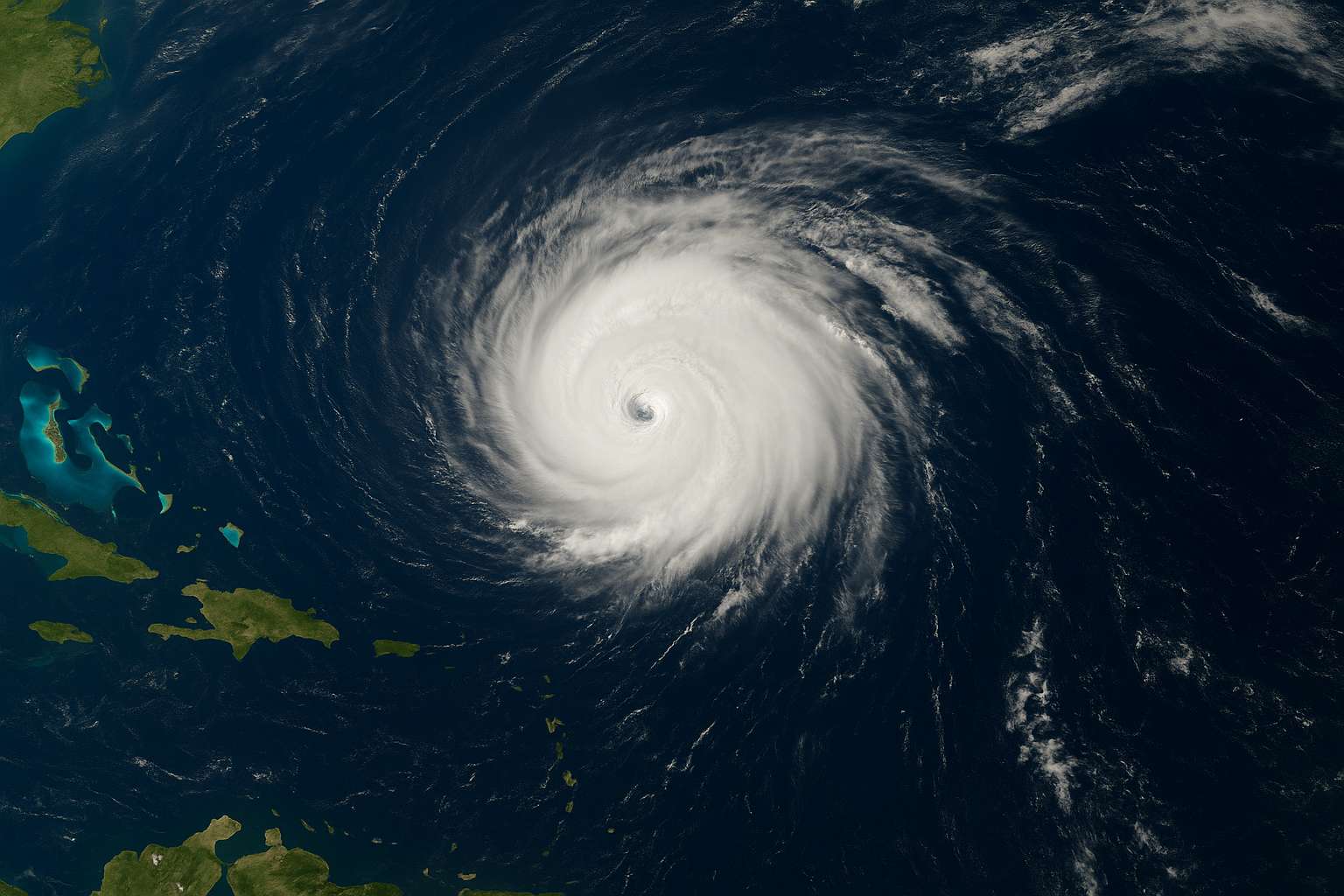Published on August 24, 2025
By: Tuhin Sarkar
Hurricane Fernand joins Erin, Beryl, Helene, Milton and Rafael as powerful Atlantic storms batter tourism in the Caribbean, Bermuda, or the North Atlantic, a report now confirms. The pattern is clear. Hurricane Fernand joins Erin, Beryl, Helene, Milton and Rafael in proving that the Atlantic hurricane season of 2024 and 2025 has reshaped how we understand travel risks. Each system has carried its own power, its own path, and its own impact on tourism, yet together they send one message. The Atlantic is active, and the Caribbean, Bermuda, and the North Atlantic must prepare for repeated disruptions.
Hurricane Fernand now adds with Erin, Beryl, Helene, Milton and Rafael in showing how quickly storms grow when seas are warm. The storms have been powerful and fast-moving, often leaving limited time for reaction. The Caribbean felt the strike of Hurricane Beryl. The United States endured the power of Hurricane Helene and Hurricane Milton. Bermuda tracked Hurricane Erin, while Hurricane Rafael roared late in the season. Now Hurricane Fernand has appeared, reminding everyone that the Atlantic remains restless.
Advertisement
Advertisement
For travellers, this means vigilance. For airlines, cruise ships, and hotels, it means planning and resilience. Hurricane Fernand joins Erin, Beryl, Helene, Milton and Rafael in battering tourism, forcing cancellations, delays, and last-minute changes. From the Caribbean to Bermuda to the North Atlantic, tourism cannot ignore the risks. This report examines why the storms of 2024 and 2025 matter, and why the next names on the list may add more pressure in the weeks ahead.
Tropical Storm Fernand has formed in the Atlantic just days after Hurricane Erin left its mark. The system is moving north of the Leeward Islands and is expected to gain strength as it tracks across warm waters. Bermuda, Canada, and even Europe could feel impacts in the days ahead.
Fernand Emerges After Hurricane Erin
The Atlantic hurricane season continues to show its force. Tropical Storm Fernand developed quickly after a tropical rainstorm north of the Leeward Islands gained strength. Meteorologists confirmed its name on Saturday afternoon. The storm comes immediately after Hurricane Erin, which had exploded in intensity earlier this week. Unlike Erin, Fernand is not forecast to undergo rapid intensification. Its early path shows a more modest growth, but experts warn it will still demand attention. Warm ocean waters will help fuel Fernand in the coming days.
Path of Fernand Near the Caribbean
Fernand’s track is steering north of the Leeward Islands. These islands stretch from Dominica and Guadeloupe to the Virgin Islands. The storm is expected to bring limited showers and thunderstorms. Impacts will be lighter than those caused by Hurricane Erin. Puerto Rico is forecast to see little or no direct impact, though a plume of tropical moisture could bring scattered storms. Because Fernand turned north sooner than Erin, it will avoid the United States mainland. That early turn also shifts its threat away from the Caribbean, limiting its local damage.
Bermuda Watches the Forecast
Bermuda is in focus as Fernand moves east of the island. The exact track and intensity will decide how strong the impacts are early next week. If the storm passes close enough, Bermuda may face rough seas, strong winds, and heavy rainfall. If the track shifts farther east, the island could escape with little or no damage. Meteorologists highlight that Fernand is smaller in size compared to Erin. That means Bermuda’s risk is lower, but the storm still poses a real threat if it shifts west.
Canada Could Face Midweek Impacts
After Bermuda, Fernand’s path could extend towards Atlantic Canada. Newfoundland in particular may experience rough seas, gusty winds, and heavy rainfall between Wednesday and Thursday. Storm systems like Fernand often maintain enough energy across the North Atlantic to reach Canada’s east coast. For travellers, the risk of disrupted ferry routes, cruise schedules, and flight delays is real. Authorities in Newfoundland will monitor forecasts closely as the storm approaches midweek.
Europe May See Remnants of Fernand
Beyond Bermuda and Canada, Fernand may survive its trek across the North Atlantic. Forecasts suggest its remnants could reach Iceland and the United Kingdom by late next week. These regions may see periods of rain, gusty winds, and unsettled seas. While the storm will weaken over colder waters, maritime travel could face delays. Europe has a history of feeling the final stages of Atlantic storms, and Fernand looks likely to continue that pattern. For airlines and cruise operators, early warnings are vital to avoid disruption.
How Fernand Differs From Erin
One reason Fernand is less threatening than Erin is its size. Hurricane Erin grew quickly and struck with explosive intensity. Fernand, by contrast, is more spread out and slower to strengthen. Meteorologists say conditions are favourable for Fernand to become a moderate or strong tropical storm. However, the chance of it becoming a major hurricane is slim. The smaller size means less destructive power, but indirect effects like rough seas can still disrupt shipping and travel. This distinction explains why Fernand is being tracked but not feared in the same way Erin was.
Additional Areas Being Monitored
AccuWeather reports show that Fernand is not the only system under watch. A tropical wave of low pressure is moving across the Atlantic. On its path, it could reach the Windward Islands and brush northern South America. This wave may bring drenching rain and gusty storms. While its development into a storm is uncertain, it reminds us that the 2025 Atlantic season is active. Travellers in the Caribbean and South America must remain alert. Airlines and cruise operators are preparing for possible route adjustments.
Implications for Travel and Tourism
Tropical storms like Fernand affect more than weather forecasts. They have real impacts on travel and tourism. In Bermuda, cruise itineraries could be rerouted. In Canada, ferries and flights may be disrupted. In Europe, shipping and aviation routes may be adjusted for safety. For hotels, last-minute cancellations or extended stays can change revenue flows. The travel sector must adapt quickly when storms alter plans. Clear communication with travellers is key to maintaining trust and safety during active storm periods.
The Atlantic Ocean has once again shown its force. In 2025, Hurricane Erin became the first major storm of the season, forming in late summer and peaking as a powerful Category 5 system. It follows on the heels of 2024, one of the most active years in modern history, when 11 hurricanes, including five major ones, swept across the basin. These storms brought destruction, disrupted travel, and reshaped how countries prepare for climate-driven weather risks. This report looks at the storms of 2024 and 2025 and explains why they matter for tourism, travel, and global safety.
Hurricane Erin 2025 Marks the Start of a Fierce Season
The 2025 Atlantic hurricane season began with several weaker tropical storms. Andrea, Barry, and Chantal all reached named status but never strengthened into hurricanes. That changed when Hurricane Erin developed over warm waters in August. It rapidly intensified into a Category 5 storm with winds of 160 miles per hour and a minimum pressure of 915 millibars.
Erin’s path thankfully kept it over open waters. It spared the United States from direct impact but caused dangerous waves and shipping delays. Bermuda and parts of the Canadian Atlantic watched closely as the storm curved east. Erin showed how quickly systems can strengthen when ocean waters are warm and conditions are favourable. The storm reminded forecasters and travellers that even one powerful cyclone can reshape an entire season.
Tropical Storm Fernand Right Now Impacting US Tourism
Shortly after Erin, Tropical Storm Fernand formed north of the Leeward Islands. Unlike Erin, Fernand did not intensify explosively. It remained smaller, with a wider spread of thunderstorms but lower wind speeds. Its path steered it east of Bermuda, bringing rough seas but little direct damage.
Fernand highlighted the constant cycle of storms during active years. It also showed how difficult forecasting can be. A shift of just a few hundred miles west could have brought stronger winds to Bermuda or even parts of Canada. For airlines, cruise operators, and holidaymakers, such storms mean flexibility is essential.
Looking Back at 2024: A Historic Year of Storms
The 2024 Atlantic hurricane season was one of the most active on record. It produced 18 named storms, 11 hurricanes, and five major hurricanes. It was not just the number but also the intensity that caught global attention.
Hurricane Beryl became the earliest Category 5 hurricane ever recorded in the Atlantic. Forming in late June, it tore across the Caribbean, breaking records and shocking meteorologists. Later in the season, Hurricane Helene struck Florida’s Big Bend region as a Category 4 storm. It caused deadly flooding through the Appalachian region, showing how inland areas can suffer as much as coastal zones.
Hurricane Milton was the strongest storm of 2024. It peaked as a Category 5 over the Gulf of Mexico before making landfall in Florida as a Category 3. The damage was widespread, and the storm became a case study in rapid intensification.
Other hurricanes like Ernesto, Francine, Isaac, Kirk, Leslie, Oscar, and Rafael left their marks across the Caribbean, the Gulf, and the Atlantic. Oscar struck Cuba, while Rafael became one of the strongest November hurricanes ever recorded in the Gulf of Mexico.
Why These Hurricanes Matter
For local communities, hurricanes bring devastation. Homes are damaged, power is lost, and lives are disrupted. For the travel industry, the impact is also major. Airports close, cruise itineraries are cancelled, and tourists are stranded. The economic effect ripples across hotels, restaurants, and entire regions dependent on visitor spending.
In the Caribbean, where tourism is often the backbone of the economy, storms like Beryl and Milton caused both physical damage and reputational harm. Travellers may avoid destinations they see as risky, even after storms pass. In the United States, events like Hurricane Helene showed how far inland flooding can disrupt travel and tourism, not just coastal holidays.
Climate Change and Stronger Hurricanes
One of the reasons behind these stronger storms is the rise in ocean temperatures. Warm seas provide the fuel hurricanes need to intensify. In 2024 and 2025, sea-surface temperatures across the Atlantic reached record highs. This helped storms like Beryl, Helene, Milton, and Erin reach Category 4 or 5 intensity.
Scientists warn that climate change is making hurricanes more frequent and more intense. They also note that storms are bringing heavier rainfall, causing deadly flooding even far from coastlines. For countries around the Atlantic, this means that hurricane preparedness is no longer just a coastal issue but a national priority.
Impact on Global Travel
Hurricanes do not just affect the countries they strike. They also disrupt global travel networks. A storm in the Caribbean can ripple through flight schedules across North America and Europe. Cruise ships reroute to avoid storms, causing passengers to miss planned stops. Cargo ships delay, affecting supply chains.
In July 2025, as Erin and Fernand moved across the Atlantic, flights between Europe and the United States experienced turbulence and delays. Shipping lanes were temporarily closed in areas of rough seas. These disruptions add costs to airlines and shipping companies, which can then pass on costs to consumers.
Lessons for the Tourism Industry
The storms of 2024 and 2025 show that the tourism industry must adapt. Hotels and resorts in hurricane-prone areas need stronger buildings and better evacuation plans. Airlines and cruise operators must communicate clearly with passengers when storms force changes. Travel insurance becomes more important for travellers facing last-minute cancellations.
Destinations must also invest in reputation recovery. After a storm, rapid marketing campaigns can help restore confidence. Tourists need to know when it is safe to return. Without this, recovery can take years, as seen in past storms across the Caribbean and the Gulf.
What Lies Ahead
With the 2025 season ongoing, experts warn that more storms could form. The next names on the list after Fernand are Gabrielle and Humberto. Meteorologists are tracking several waves of low pressure across the Atlantic that may develop into storms. If warm waters persist, the chance of more hurricanes is high.
For the United States, Caribbean nations, Bermuda, and Atlantic Canada, the message is clear: stay prepared. Europe, too, must watch carefully, as weakened but still powerful storms can reach the UK and Iceland. The record of 2024 and the early signs of 2025 suggest that this era of intense hurricane activity is not slowing down.
A Call to Prepare and Adapt
Hurricane Erin in 2025 and the storms of 2024 tell the same story. The Atlantic is producing stronger, more frequent storms that test the limits of communities, economies, and the travel industry. For governments, the challenge is to build stronger defences and better emergency responses. For the tourism industry, the challenge is to protect visitors, maintain trust, and rebuild quickly.
For travellers, the lesson is simple but important. Flexibility, awareness, and preparation are key to safe travel during hurricane season. Climate change ensures that storms like Beryl, Helene, Milton, and Erin will not be rare events. They will be part of a new normal that the world must learn to live with.
The Broader 2025 Atlantic Season
Fernand is the latest name on the 2025 Atlantic storm list. It follows Erin, and the next names are Gabrielle and Humberto. Meteorologists warn that the season remains very active, with warm seas fuelling storm development. Communities across the Atlantic basin must stay ready for further systems. For tourists, the message is clear: flexibility is vital. Those travelling to the Caribbean, Bermuda, or North Atlantic regions should monitor advisories daily. Insurance, flexible bookings, and direct contact with airlines and cruise lines can help reduce stress.
Preparedness is Key
Tropical Storm Fernand may not reach the same strength as Hurricane Erin, but it still matters. Its path takes it east of Bermuda, close to Canada, and possibly into Europe. Each region must prepare for rough seas, strong winds, and travel disruptions. Fernand proves once again that even smaller storms can have wide-reaching effects. For the travel industry, storm season requires readiness, clear updates, and careful planning. For travellers, it means staying alert, being flexible, and prioritising safety over schedules. The Atlantic is active, and Fernand is a reminder of that reality.
Advertisement
Advertisement
Tags: Atlantic storms, Bermuda weather, Hurricane Erin, Tropical Storm Fernand
I want to receive travel news and trade event update from Travel And Tour World. I have read Travel And Tour World’sPrivacy Notice.
Sunday, August 24, 2025
Sunday, August 24, 2025
Sunday, August 24, 2025
Sunday, August 24, 2025
Sunday, August 24, 2025
Saturday, August 23, 2025
Sunday, August 24, 2025
Saturday, August 23, 2025




